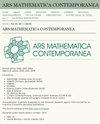Quotients of skew morphisms of cyclic groups
IF 0.9
3区 数学
Q3 MATHEMATICS
引用次数: 2
Abstract
A skew morphism of a finite group $B$ is a permutation $\varphi$ of $B$ that preserves the identity element of $B$ and has the property that for every $a\in B$ there exists a positive integer $i_a$ such that $\varphi(ab) = \varphi(a)\varphi^{i_a}(b)$ for all $b\in B$. The problem of classifying skew morphisms for all finite cyclic groups is notoriously hard, with no such classification available up to date. Each skew morphism $\varphi$ of $\mathbb{Z}_n$ is closely related to a specific skew morphism of $\mathbb{Z}_{|\!\langle \varphi \rangle\!|}$, called the quotient of $\varphi$. In this paper, we use this relationship and other observations to prove new theorems about skew morphisms of finite cyclic groups. In particular, we classify skew morphisms for all cyclic groups of order $2^em$ with $e\in \{0,1,2,3,4\}$ and $m$ odd and square-free. We also develop an algorithm for finding skew morphisms of cyclic groups, and implement this algorithm in MAGMA to obtain a census of all skew morphisms for cyclic groups of order up to $161$. During the preparation of this paper we noticed a few flaws in Section~5 of the paper Cyclic complements and skew morphisms of groups [J. Algebra 453 (2016), 68-100]. We propose and prove weaker versions of the problematic original assertions (namely Lemma 5.3(b), Theorem 5.6 and Corollary 5.7), and show that our modifications can be used to fix all consequent proofs (in the aforementioned paper) that use at least one of those problematic assertions.环群的偏态商
有限群$B$的偏态射是$B$的一个排列$\varphi$,它保留了$B$的单位元,并且具有这样的性质:对于B$中的每一个$ A \,存在一个正整数$i_a$,使得$\varphi(ab) = \varphi(A)\varphi^{i_a}(B)$对于B$中的所有$B \。对所有有限循环群的斜态射进行分类是出了名的困难,目前还没有这样的分类。$\mathbb{Z}_n$的每个偏态$\varphi$与$\mathbb{Z}_{|\!\langle \varphi \rangle\!|}$,称为$\varphi$的商。本文利用这一关系和其他观察结果,证明了有限循环群的斜态射的一些新定理。特别地,我们对所有$2^em$阶循环群的偏态进行了分类,其中$e\ In \{0,1,2,3,4\}$和$m$为奇数和无平方。我们还开发了一种寻找环群的偏态射的算法,并在MAGMA中实现了该算法,得到了阶为$161$的环群的所有偏态射的普查。在本文的准备过程中,我们注意到论文环补和群的偏态射的第~5节有一些缺陷[J]。代数[j]., 2016,(6), 68-100。我们提出并证明了有问题的原始断言的弱版本(即引理5.3(b),定理5.6和推论5.7),并表明我们的修改可以用于修复使用这些有问题断言中的至少一个的所有结果证明(在上述论文中)。
本文章由计算机程序翻译,如有差异,请以英文原文为准。
求助全文
约1分钟内获得全文
求助全文
来源期刊

Ars Mathematica Contemporanea
MATHEMATICS, APPLIED-MATHEMATICS
CiteScore
1.70
自引率
0.00%
发文量
45
审稿时长
>12 weeks
期刊介绍:
Ars mathematica contemporanea will publish high-quality articles in contemporary mathematics that arise from the discrete and concrete mathematics paradigm. It will favor themes that combine at least two different fields of mathematics. In particular, we welcome papers intersecting discrete mathematics with other branches of mathematics, such as algebra, geometry, topology, theoretical computer science, and combinatorics. The name of the journal was chosen carefully. Symmetry is certainly a theme that is quite welcome to the journal, as it is through symmetry that mathematics comes closest to art.
 求助内容:
求助内容: 应助结果提醒方式:
应助结果提醒方式:


